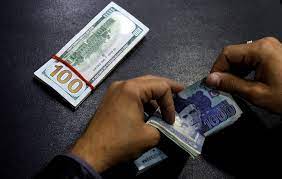Publisher: Maaal International Media Company
License: 465734
Pakistan Rupee Slumps to Record as IMF Bailout Urgency Grows
Pakistan’s currency tumbled to a record low as the crisis-stricken government relaxed its grip to win much-needed loans from the International Monetary Fund, Bloomberg reported.
With $6.5 billion of IMF lending stalled and a debt default on the horizon, the decline in the currency indicates Prime Minister Shehbaz Sharif’s resolve in winning approval for the much-needed funds. The central bank this week also raised interest rates to a 24-year high to fight surging prices.
The rupee slid as low as 242.25 to the greenback on Thursday, surpassing the previous all-time trough of 240.375 set in July, according to data compiled by Bloomberg. Owais-ul-Haq, a trader from Arif Habib Ltd.’s foreign-exchange desk, said Pakistan’s currency touched 250 a dollar.
اقرأ المزيد
“Pakistan is showing its willingness and finally conceding to IMF demands to secure funds after a long period of reluctance,” said Naveed Vakil, chief operating officer at AKD Securities Pvt Ltd. in Karachi. “The IMF is firmly positioned on Pakistan maintaining a market-based exchange rate and today’s move has given markets the confidence that officials will now complete the remaining required conditions to continue the IMF program.”
Dollar Crunch
Dollar-strapped nations seeking aid from the IMF are facing growing pressure to allow market forces to play a greater role in setting their exchange rates. While Pakistan won a bailout last year, the IMF has delayed the release of funds and the nation is battling to keep its economy afloat as power outages, dollar shortages, and political tensions threaten to sink the nation deeper into crisis.
Pakistan’s benchmark KSE-100 Index rose 2.4%, the most in five months, after the currency drop showed the nation is willing to comply with IMF demands.
Pakistan’s money exchange companies removed the limit on the dollar-rupee rate from Wednesday, and said they will let the local currency drop slowly in the open market. Supply of dollars among onshore money-changing businesses has dried up as locals turn to the black market, with the greenback being sold at about 10% above advertised rates.
“The rupee will continue to weaken and may hit 260 a dollar by end-June,” said Amreen Soorani, head of research at JS Global Capital Ltd. in Karachi. “We are witnessing pressure on dollar reserves and there hasn’t been any fresh inflows that would give any meaningful increase to reserves.”








